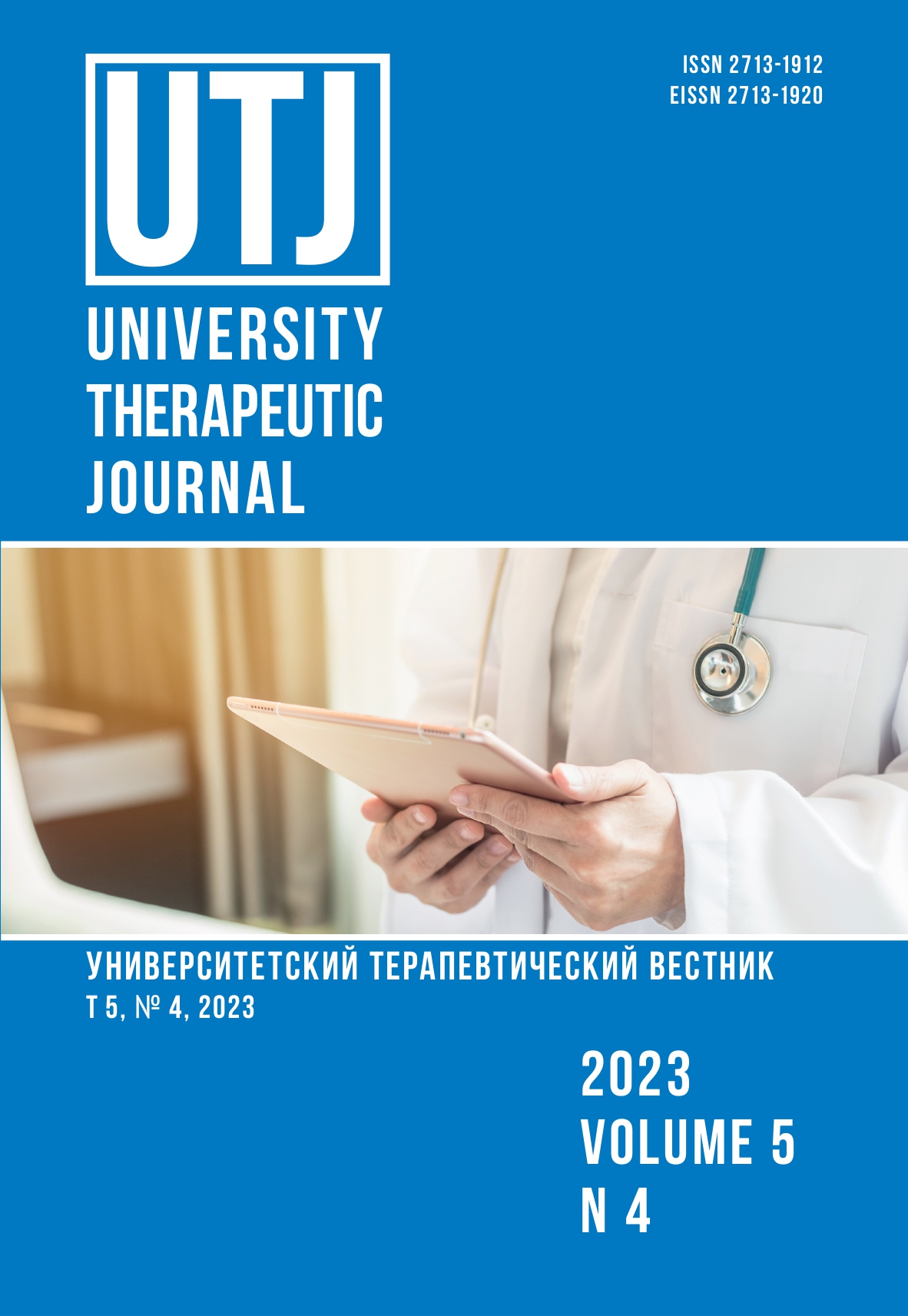SURGICAL TREATMENT OF PERSISTENT HYPERPARATHYROIDISM
Abstract
Introduction. Persistent or recurrent primary hyperparathyroidism (PHPT) is detected in 3.4–6.5 % and is an unsatisfactory outcome of the operation to remove parathyroid tumors. Persistence is diagnosed when hypercalcemia appears up to 6 months after surgery. If it occurs at a later date, hyperparathyroidism is considered to be recurrent. Persistent or recurrent forms of PHPT usually requirerepeated operation, although determination of indications should be individualized. Materials and methods. There were 546 patients with PHPT aged from 6 to 82 years were operated on during the period from 1973 to 2022 on in our clinic. All the patients underwent bilateral revision of the neck, removal of parathyroid tumors. Persistence of PHPT was diagnosed in 9 (1.6 %) patients. Results and discussion. Persistent hypercalcemia and an increase in the level of parathyroid hormone were detected in the period from 1 to 6 month after the initial operation in all 9 patients. The level of total calcium was 2.65–3.55 mmol/l. Three patients with mild hypercalcemia and absence of clinical symptoms had negative ultrasound and SPECTCT results. These patients are left for observation. One patient refused examination and further treatment. Repeated surgical interventions for persistent PHPT were performed in 5 patients. The study analyzes the main predisposing factors of persistence at the diagnostic and operational stages. Revision errors during the primary surgery were found in 3 patients and in 2 cases — by the retrosternal location of the tumor. Conclusions. The main reasons for the persistence of hyperparathyroidism are the inadequate volume of the primary operation and ectopic parathyroid adenoma in the mediastinum. The use of high-tech research methods (SPECT-CT and MSCT) in a difficult diagnostic situation makes it possible to perform an accurate topical diagnosis of ectopic adenoma and choose the optimal method of surgical intervention. Use of the da Vinci robotic system made it possible to remove mediastinal adenoma with minimal surgical trauma.
References
Алаев Д.С., Калинин А.П., Котова И.В. и др. Повторные операции при первичном гиперпаратиреозе. Практическая медицина. 2012; 9(12): 103–5.
Белобородов В.А., Степанов И.А., Ховалыг Т.В. Повторные операции при первичном гиперпаратиреозе. Таврический медико-биологический вестник. 2022; 25(3): 37–40. DOI: 10.29039/2070-8092-2022-25-3-37-40.
Ветшев П.С., Аблицов А.Ю., Животов В.А., Дрожжин А.Ю. Хирургическое лечение первичного гиперпаратиреоза с редкой эктопией аденомы околощитовидной железы. Вестник НМХЦ им. Н.И. Пирогова. 2018; 13(1): 58–61.
Гостимский А.В., Матвеева З.С., Романчишен А.Ф. и др. Первичный гиперпаратиреоз в детском возрасте. Педиатр. 2017; 8(5): 20–4.
Дедов И.И., Мельниченко Г.А., Мокрышева Н.Г. и соавт. Первичный гиперпаратиреоз: клиника, диагностика, дифференциальная диагностика, методы лечения. Проблемы эндокринологии. 2016; 62(6): 40–77. DOI: 10.14341/probl201662640-77.
Мокрышева Н.Г., Еремкина А.К., Мирная С.С. и др. Клинические рекомендации по первичному гиперпаратиреозу. Проблемы эндокринологии 2021; 67(4): 94–124. DOI: 10.14341/probl12801.
Наджафова К.Н., Ковалев Ю.Р., Курникова Е.А., Исаков В.А. Хроническая болезнь почек и вторичный гиперпаратиреоз: причинно следственные связи. Медицина: теория и практика. 2019; 4(2): 27–34.
Романчишен А.Ф., Демидчик Ю.Н., Комиссаренко И.В. и др. Хирургия щитовидной и околощитовидных желез. СПб.: Вести; 2009.
Строев Ю.И., Чурилов Л.П. Эндокринология подростков. СПб.: ЭЛБИ; 2004.
Beggs A.D., Hain S.F. Localization of parathyroid adenomas using 11C-methionine positron emission tomography. Nucl. Med. Commun. 2005; 26(2): 133–6. DOI: 10.1097/00006231-200502000-00009.
Bergenfelz A., van Slycke S., Makay Ö., Brunaud L. European multicentre study on outcome of surgery for sporadic primary hyperparathyroidism. British Journal of Surgery. 2021; 108(6): 675–83. DOI: 10.1002/bjs.12025.
Casara D., Rubello D., Pelizzo M., Shapiro B. Clinical role of 99m TcO 4/MIBI scan, ultrasound and intra-operative gamma probe in the performance of unilateral and minimally invasive surgery in primary hyperparathyroidism. Eur. J. Nucl. Med. 2001; 28(9): 1351–9. DOI: 10.1007/s002590100564. PMID: 24578055.
Freeman J.B., Sherman B.M., Mason E.E. Transcervicalthymectomy: an integral part of neck exploration for hyperparathyroidism. Arch. Surg. 1976; 111: 359–64. DOI: 10.1001/archsurg.1976.01360220055009.
Guerin C., Paladino N.C., Lowery A. et al. Persistent and recurrent hyperparathyroidism. Updat. Surg. 2017; 69(2): 161–9. DOI: 10.1007/s13304-017-0447-7.
Guilmette J., Sadow P.M. Parathyroid Pathology. Surgical Pathology. 2019; 12: 1007–19. DOI: 10.1016/j.path.2019.08.006.
Hendricks A., Lenschow C., Kroiss M. et al. Evaluation of diagnostic efficacy for localization of parathyroid adenoma in patients with primary hyperparathyroidism undergoing repeat surgery. Langenbecks Arch Surg. 2021; 406(5): 1615–24. DOI: 10.1007/s00423-021-02191-z.
Iacobone M., Scerrino G., Palazzo F.F. Parathyroid surgery: an evidence-based volume — outcomes analysis. Langenbecks Arch. Surg. 2019; 404: 919–27. DOI: 10.1007/s00423-019-01823-9.
Kluijfhout W.P., Pasternak J.D., Drake F.T. et al. Use of PET tracers for parathyroid localization: a systematic review and meta-analysis. Langenbeck’s Arch Surg. 2016; 401(7): 925–35. DOI: 10.1007/s00423-016-1425-0.
Kuo L.E., Wachtel H., Fraker D., Kelz R. Reoperativeparathyroidectomy: who is at risk and what is the risk? J SurgRes. 2014; 191(2): 256–61. DOI: 10.1016/j.jss.2014.05.073.
Nawrot I., Chudziński W., Ciąćka T. et al. Reoperations for persistent or recurrent primary hyperparathyroidism: results of a retrospective cohort study at a tertiary referral center. Med. Sci. Monit. 2014; 20: 1604–12. DOI: 10.12659/MSM.890983.
Silva B.C., Cusano N.E., Bilezikian J.P. Primary hyperparathyroidism. Best Pract. Res. Clin. Endocrinol. Metab. 2018; 101247. DOI: 10.1016/j.beem.2018.09.013.


